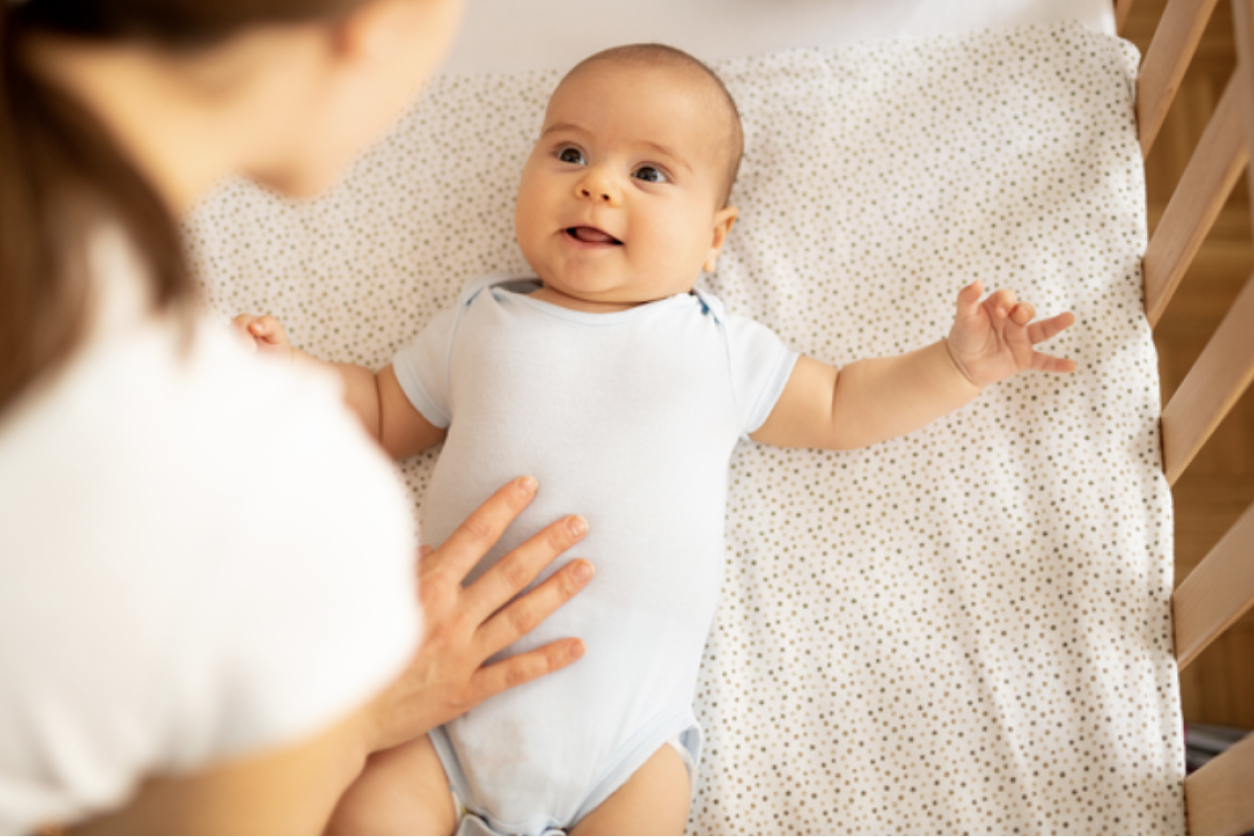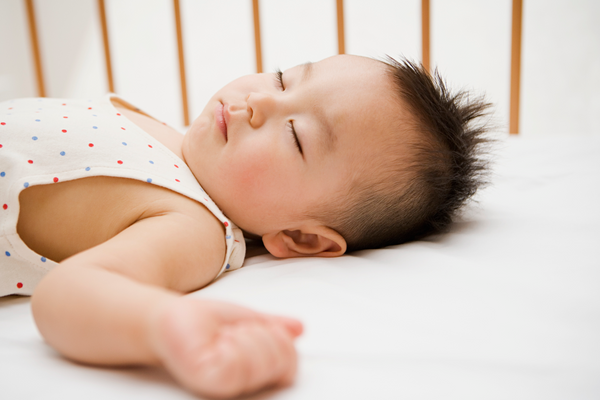Whether you’re a first-time parent or you’ve been through this before, there’s a lot to learn about your baby’s health and well-being. There’s a learning curve as you start the cycle of feedings, naps, and tummy time, all while learning how your baby communicates their wants and needs. One important factor is how to tell if baby is breathing properly, as these signals tell you that baby is healthy and comfortable.
What can affect a baby or a newborn’s breathing?
From normal newborn congestion and sneezing, to grunting in a new sleeping position, to a colicky episode, there are many things that can affect the quality and sound of your baby’s breathing. Common things that can negatively affect a baby’s breathing are certain respiratory illnesses like bronchitis or a cold; croup, which is a viral infection of their windpipe; an allergic reaction; asthma; or if there’s a foreign object in their airway. Understanding what the signs of breathing difficulties in your baby are can help you determine when a change in breathing pattern or sound is normal and when it’s time to call the doctor.
How can I tell if my baby is breathing properly?
These seven major signs can be signs that your baby’s breathing pattern has changed.
While these tips are helpful to assess an ongoing situation, this does not replace the advice of a medical professional. Please speak to a pediatrician, pediatric nurse, or other medical professional for serious concerns and personalized care.
1. Healthy skin color
Observing your child's skin color may help identify signs of respiratory distress. When your baby is first born and takes their first breaths and cries, their skin turns from a purplish color to pink. A newborn’s skin should remain pink (or slightly yellow from jaundice during the first week of life) with the exception of a slight blue tint to hands and feet. This is normal because your baby’s blood circulation isn’t quite mature yet. You might also see a blue or purple tint on the outside of your baby’s lips or around their mouth when they cry, and that’s completely normal, too! When they stop crying, though, their lips should turn back to pink.
If you see a bluish tint on their body (aside from the above exceptions) or inside their mouth/inner lip, it may be a sign that their oxygen level is low, and you should contact your pediatrician or go to the hospital immediately.
2. Normal resting heart rate
A baby’s heart rate is typically much faster than an adult’s. Depending on the age of your baby, their activity level at the time you measure it, if they are sleeping or crying, or feverish, their heartbeat can range from 70 to 190 beats per minute. Speak with your doctor if you have questions about your child’s heart rate . Once you have an understanding of your child’s typical heart rate, significant fluctuations may occur in conjunction with changes in their breathing patterns and a reason to pay attention to their comfort of breathing and if any concerns contact your pediatrician .,
To take your infant’s pulse, lay your baby down with their arm bent so their hand is by their ear. Then, feel for their pulse over their heart or between their elbow and shoulder. Gently press two fingers where you feel a heartbeat for 15 seconds. Count every time you feel a beat for those 15 seconds. Then, multiply those beats by four to get your baby’s heart rate per minute.
3. No retractions
Retractions are when the area between a baby’s ribs and neck sink in or appear to be pulling in when they breathe. This is one of the most important signs to look for if you suspect your baby has breathing issues. Retractions are common when babies are working harder to fill their lungs with air. If you see that your child has retractions, sit them upright in a comfortable position and call your pediatrician.
4. Look at their nose and mouth
Babies breathe exclusively through their nose until 4 months of age. While breathing may sound snorty if an infant or child is congested, there should not be any significant flaring of your baby’s nostrils if they’re breathing comfortably. If you observe flaring nostrils, your baby may be working harder to breathe and you should contact your pediatrician or be seen in an emergency room.
5. There are no noises
Your baby’s normal breathing is either quiet or sometimes a bit snorty from typical infant congestion. If breathing is more difficult than usual, you may hear them make some unusual noises. Some of these noises include:
- Wheezing: This faint whistling-like sound is typically heard when exhaling and is often only heard by stethoscope. Depending on the child’s age it could be a sign of bronchiolitis, asthma or reactive airway disease. Wheezing is a sign of small airway constriction
- Stridor: This high-pitched sound, typically heard on inhalation, can be a sign of upper airway inflammation.
- Stertor: This sound resembles snoring and is typically associated with a cold or congestion.
6. No significant change in posture
Similar to an adult, older infants will try to change their posture to improve their breathing if they are having difficulty. For example, they might lean forward or tilt their head up. Different positions might signal your newborn is trying hard to breathe. If their head and neck position seems different than normal, look for other signs of increased work of breathing to ensure the position isn’t a concern
Tips for monitoring your baby’s breathing
Monitoring is among the best steps you can take to get an idea for what normal breathing looks like for your baby. These three tips can help you learn what’s normal and better spot when something may be amiss.
Get a baseline for what’s normal for your baby
While you may initially be concerned when you observe a change in breathing patterns, keep in mind that some of these changes may be perfectly normal. Some babies may occasionally breathe with their mouth slightly open, be chronically congested, or have a heart rate that is faster than their peers. If that’s the norm for your baby, then that can help you rule out breathing issues. Here are some breathing methods you may recognize:
-
Belly breathing, or diaphragmatic breathing, is essential for newborns as it supports their natural development and relaxation. Unlike adults, babies rely heavily on their diaphragm for deep breaths, helping to strengthen their tiny lungs and regulate oxygen flow. Encouraging belly breathing in infants can promote better sleep, soothe fussiness, and contribute to overall wellness.
-
Mouth breathing may occasionally be seen, especially when babies are congested or upset. While it’s usually not a concern, prolonged or habitual mouth breathing should be monitored to ensure that it isn’t linked to an underlying issue.
-
Retracted breathing—when a baby’s chest visibly pulls in with each breath—can sometimes be seen during crying or feeding, as babies naturally work a little harder to breathe in those moments. However, it should not be a typical breathing pattern when your baby is at rest. If you frequently notice retractions along with other signs like flared nostrils, grunting, or rapid breathing, it’s a good idea to consult a healthcare provider.
Monitoring your baby’s typical breathing patterns—including belly breathing, occasional mouth breathing, and mild retractions—can help you distinguish what is normal from what may require a closer look by a healthcare provider.
Use breathing wear to learn your child’s typical patterns
Breathing wear covers a category of specialized wearable tech that can help track your baby’s normal breathing. These soft pieces, typically placed on a baby’s foot or gently wrapped around their body, can help parents get peace of mind through the tracked insights. This helps set a baseline for what’s normal for your child, and you can use these data to compare any changes when you’re not sure if their breathing is affected.
Nanit’s Breathing Wear line grows with your child, from the newborn stage to 24 months. Available in swaddle, sleeping bag, and wrap models, breathing wear pairs with Nanit Pro Camera’s computer vision technology to detect and monitor your child’s breathing. The sensor-free, radar-free Breathing Wear is machine washable and dryer-safe. The accompanying app tracks your baby’s breaths per minute, and sends your real-time alerts on the app if anything veers from the norm.
Understand your child’s mood changes
Knowing what keeps your baby happy – and what makes them not so happy – can help rule out whether a breathing issue is in the mix. If they’re typically cranky around 4 p.m. or take a while to wake up after a nap, you can safely attribute that to their typical temperament . But once things begin deviating from the norm, that’s when you may want to check for other signs of wellness.
Key Takeaways
As you get to learn your baby’s temperament, habits, and preferences, take a closer look at their typical breathing patterns. This includes looking for signs of rapid breathing or unusual pauses. Knowing what’s normal for your baby – and what’s atypical for all babies – can help you monitor your baby’s health with confidence. Familiarity with these patterns aids in identifying potential breathing problems early. And with added assurance from helpful babywear like Nanit’s, you can rest easy knowing what’s expected and when you need to call the doctor.








































